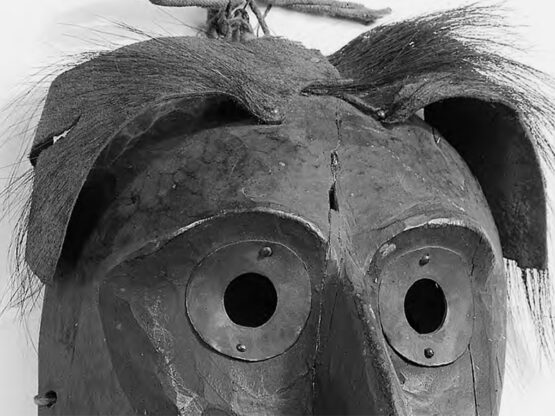Thinking for strategic, brand and global difference, client
REFLECTIONS ON LECTURES AND SOURCE MATERIAL
LECTURE
Q: How do you develop a strategy and project plan for a client / audience in a continually evolving global market?
One thing that is universally agreed by the lecturers is that every project is unique with its own set of requirements, and as such each strategy document has to be bespoke to solve the specific task in hand. However, the methods that are employed to achieve this are essentially the same. Wouter Dirks of Studio Dunbar also adds that the strategy can change over a period of time and the information within has to be monitored and amended as required - so it is a flexible system.
Desk research is initially carried out which is a snapshot of personally gathered research to gain a greater understanding of the market, your client and their product or service. This may or may not be supported with client research. On meeting the client you can dive further into the project by asking the right kinds of questions, gaining trust and ensuring you are speaking the same language. I personally find it useful to try to adopt their way of describing parts of the process so we clearly understand each other and what we are both referring to.
In the absence of having a market research document from the client it is important to look at the target audience and start to build a profile. This includes looking at global trends. The insights gained will help to influence how you manage your projects. It can also be useful to interview the key stakeholders client side to get multiple perspectives. Accept and Proceed reach out to the client's consumers and conduct 'deep dive' audience reviews. They look at consumers and non-consumers to gain new insights. These can be carried out through questionnaires or workshops. The client will also have a unique understanding of where the markets are and how they see their product/service and it's performance or gaps.
All of the component parts: Global and regional market trends, client insights, audience participation, questionnaires and workshops go some way towards informing your design brief, strategy and client project plan.
TAKE OUTS
— Do some desk research to understand your client, their business, the market and trends
— Prepare a list of questions that are specific to the problem
— Meet the client and key stakeholders
— Reach out to key stakeholders in the business and the target audience to gain new perspectives and insights
— Understand and speak the same language
— Partner with your client and keep them involved in the process
— Understand the target audience – who is going to use this product or service?
— Look at all levels of society as well as non-consumers
— Create a questionnaire or have a workshop with the audience
— If the client has a research document they may also have a strategy and project plan in place. Test it and question it
— Collate your findings to inform your brief, design strategy and project plan
—
RESOURCES
ON DESIGN STRATEGY AND PROJECT PLANNING:
In reading the chapters of Peter L. Phillips book (creating the perfect design brief) the following information needs to be compiled when building your strategy document and project plan:
Target Audience Review/create a profile: Interests, Income, Educations, Gender (if relevant), Ethnicity (if relevant).
Brand Audit: Overview of clients products/services, stakeholders, market share, quality of offering, price point, Global/International reach.
Competitor Audit (Comparative study): Overview of 3 brand leaders products/services, stakeholders, market share, quality of offering, price point, Global/International reach.
Visual Audit: Matrix showing all aspects of customer facing communication (client and competitors).
Project scope, timeline and budget: Phased process covering research, concept development, testing, concept refinement and implementation.
Appendix: Used for gathered materials that do not sit within one of the above categories or visual research content.
...
ON OVERCOMING OBSTACLES:
From Peters list my personal obstacles are as follows:
— Fear of authority
— Risk avoidance
— Procrastination
— Confused priorities
— Lack of constructive feedback/support
I see myself as a dedicated, passionate, self-motivated, hard working designer with a flair for creative thinking, execution and attention to detail. I feel that others have not taken me seriously in the past for more senior roles because I sometimes come across as negative and was not seen as a team player. It is true that I have suffered with depression for most of my adult life, but I tried to keep this from others and kept work on a strictly professional level.
Anyhow - I do see putting a personal plan for self improvement together as a positive and will start to bring this into my daily routine in small steps.
My environmental obstacles are as follows:
— Lack of time.
— Lack of budget (usually to create the end result you want).
I have listed out Peter's questions to ask yourself to overcome obstacles in my sketchbook and will write a plan by the end of next week (5th Nov 2021).
Peter's notes on 'creating a plan for moving forward' were also very insightful and I have noted all the key points down for future reference. Actually think I'm going to buy this book - it's an invaluable resource.
TAKE OUTS
— The best way to deal with obstacles is to face them head on
— List the barriers to your success in detail
— Create a personal and business plan for moving ahead
— Analyse and question your business processes
— Identify your weaknesses and strengths
— Tackle the obstacles and move on
— Follow Peter's advice on gaining client confidence (see notes)
...
ON KATIE HUI
— Do it yourself
— Use creativity for good
— Know your audience: what are their aspirations?
— Ask questions
— Challenge prejudice and assumptions
— Does your audience have a narrative or story you can engage with?
...
Workshop Challenge
Research strategies and project plans used by agencies to reach a global audience. Share your findings on the Ideas Wall and elaborate in your blog.
MICHAEL JOHNSON: BRANDING IN FIVE AND A HALF STEPS (THAMES AND HUDSON 2016).
In Michael Johnson's book 'Branding' he discusses the value of a verbal strategy before coming to any visual conclusions. While the section on strategy is not about design strategy per se there is a lot of insightful material contained within its pages.
In addressing audience perception of a product/service he asserts that clients have a functional view of their brand. The why. Why people would use their product or service?. Whereby an audience will come to the same product/service emotionally asking 'why should I care?'.
Strategically he asks the questions: What are your long term ambitions, your core purpose, what is the central idea – why are you here? I think this is the starting point for any briefing question or formulation for creating a strategic document. It is important to also know what the defined set of values are for the company you are designing for. What makes them different?
He asks the following questions of his clients organisation to determine a branding strategy and design direction. The internal voice of the company and its values are the driving force behind your design approach.
VALUE QUESTIONS
— What is your ambition?
— What makes you different? How do you differentiate in a global marketplace?
— Why are you here. What problem do you exist to solve?
— What do you do and how do you do it?
— Who are you here for?
— How would you describe your values?
— What is your personality (Simple line statement of intent)?
Michael underlines the importance of working with your client and stakeholders to answer these questions because they are more likely to be invested in the process through co-authorship. Michael also points out that in answering these questions they have to result in 'real values, with real intentions'.
Your value set can be realised using a value cluster based on the following principles: Reliability, Immediacy, Togetherness, Unwavering, Spirit and Strength. But it is important for an organisation to have a point of difference. For the Science Museum at the time the book was written (2016), their brand personality was 'The home of human ingenuity'. This is not necessarily a customer/audience facing message but is the core of what a business is about outlined in a succinct way.
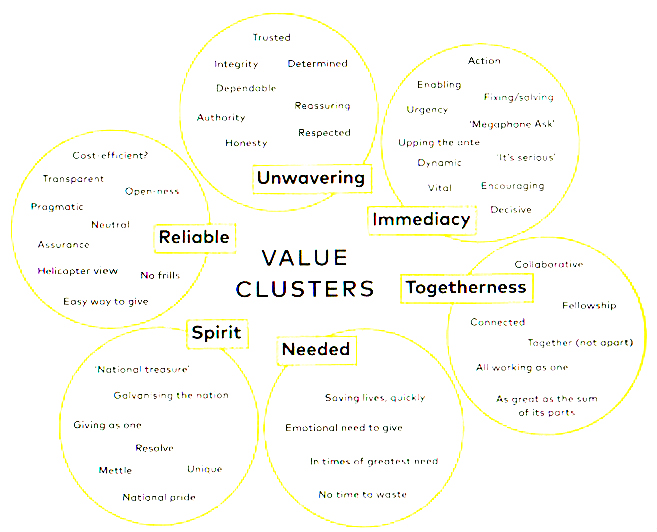
To find a brands personality the client will have the functional standpoint as discussed earlier and the audience the emotional. In terms of the Gen Y/Millennial audience or 'Generation Next' as it is sometimes referred to the will quickly see through any lack of real authenticity and look for the genuine, legit and honest. Therefore it is important to bring the audience into the process early on and speak the same language in order to tap into the emotional connection to your product or service. So from an audience perspective - what values does the Science Museum represent and what do these values mean to their audience? How does this differ between client and audience? What gaps or insights can be discovered in the process?
Michael reveals that some brands have created what is known as 'perceived authenticity' and in using first and second person dialogue have found a way to connect with their audience on a personal level. For instance: Superdry is percieved as a Japanese brand but is actually British with the closest store to Japan in South Korea. They have overcome the genuine, legit and honest by positioning themselves as a youth brand complete with pigeon english translated T-Shirts.
I think while all the above is based on brand strategy the same rules apply in gaining understanding of a pre existing brand as well as helping you to define a strategy for your design process and combined with Peter L. Phillips approaches should provide a solid foundation for you to build create your final design brief.
....
Distill your research to develop your own strategy and project plan for the selected project brief. Write a draft of your strategy and project plan and post it to your blog.
DESIGN STRATEGY AND PROJECT PLAN
—
SECTION 1:
Brief Overview
Project Question:
How do we make the Science Museum Groups online archive accessible to a broad audience, easy to read, navigate and search, and drive return and new traffic?
Objectives:
— To explore and discover prototype design solutions to present information to the public in relation to public access to the digital archive collection.
— To design a visualisation, user interface (real or imagined), or exploration tool for discovering the collection.
— To Create ideas, test, play and prototype your design solutions, which could be interactive, built, animated, machine generated “computer
vision” tags, storyboarded or presented as a series of proposed designs.
Audience:
Young adults (18 – 30 years) who are interested in the science (non-specialist, non-researcher), history, society, culture and are motivated by curiosity. The audience is potentially global and may never have visited the Science Museum Group’s physical museums.
Outcome:
Science Museum Group are considering new forms of discovery including more visually-based interfaces which allow new forms of exploration and discovery. We hope
this will bring some of the newly digitised objects to the fore and enable audiences to discover them easily and to find other objects that they might like.
Note: The above (apart from the project question) has been taken from the Science Museum Group brief, is their strategy and has been included as recommended by Peter L. Phillips when he asserts that 'strategy can be extracted from materials supplied'. This will also help me to keep the actual brief top of mind so that I do not deviate too far from what is actually expected.
—
SECTION 2:
Method: The Double Diamond.
DISCOVER
Research: My intention would be to build out the audience profile as there is quite a difference between and 18, 25 and 30 year olds in their interest set. I will write a series of questions and ask my contemporaries in the industry to ask their families to take part in a 5 minute online survey. I also intend to look at trends, a visual audit of the Science Museum Groups current practice and a maximum of 3 comparative 'competitors'. This could be a review of data already gathered with the V&A, Cooper Hewitt and AIGA Archives.
DEFINE
A distillation of the research and any further questions I may have before starting the design concept process.
DEVELOP
3 x Sketch concepts including information about how they work and interact. Proof of concept survey.
DELIVER
Refinement of one concept. Prototyping. Proof of concept. Materials and medium.
Additional to this process I would add measurement of success.
—
SECTION 3:
Phases and Scheduling
To be added…
—
SECTION 4:
Appendix:
Analytics from the Science Museum Group website.
Brand guides.
Target audience mood boards.
Results of online survey.
Visual brand audit.
Competitor audit.
Insights from audits.
Results of proof of concept survey.
—
SECTION 5:
Anticipating and overcoming obstacles:
Personal
Risk avoidance: How can I push outside of my comfort zone in this process and embrace the unknown?
Confused priorities: Make sure you prioritise and focus your energy on the right work.
Reacting: Shut up and listen.
Lack of constructive feedback or support: Make use of your tutorials.
Environmental:
Lack of time: Use your time plan wisely and try to stick to the plan.
—
Communicate the rationale for your strategy and project plan to be delivered through a five slide Keynote presentation. Record yourself outlining the rationale over five Keynote slides and upload the presentation to your blog.
SCREENSHOTS OF PDF PRESENTATION BELOW: Note that I can't seem to link either video or PDF's through my WordPress site. Hence the analog approach.
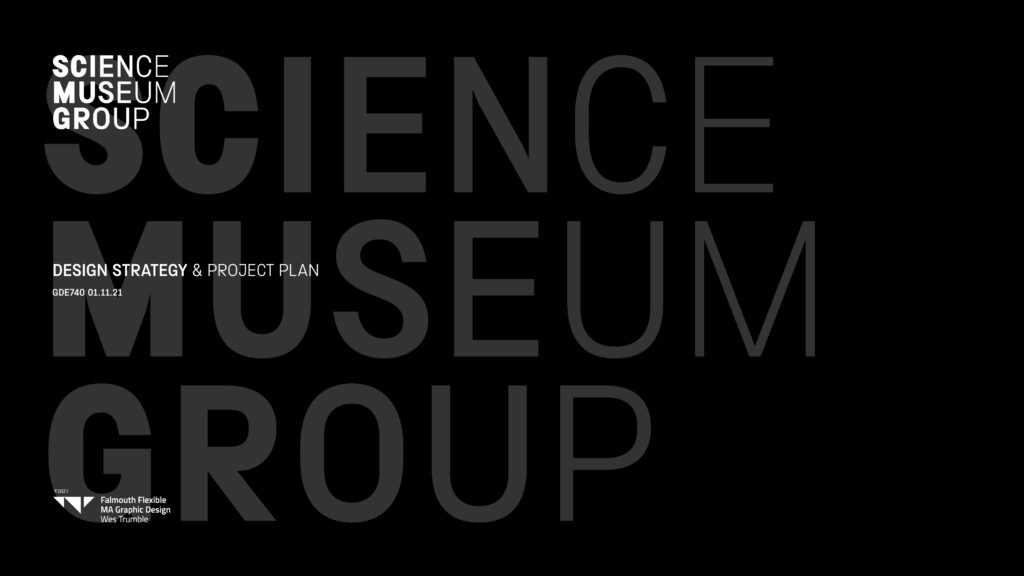
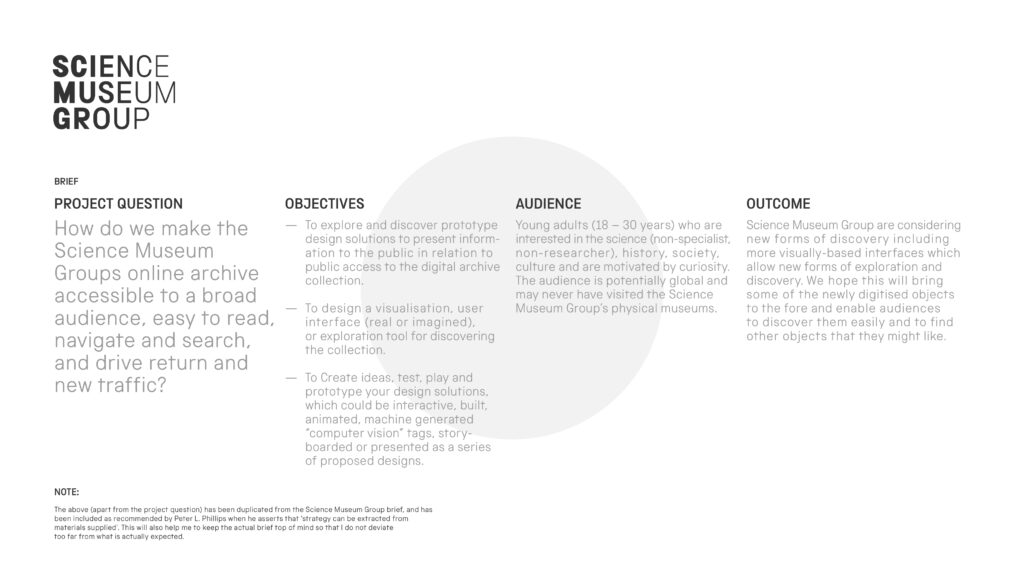
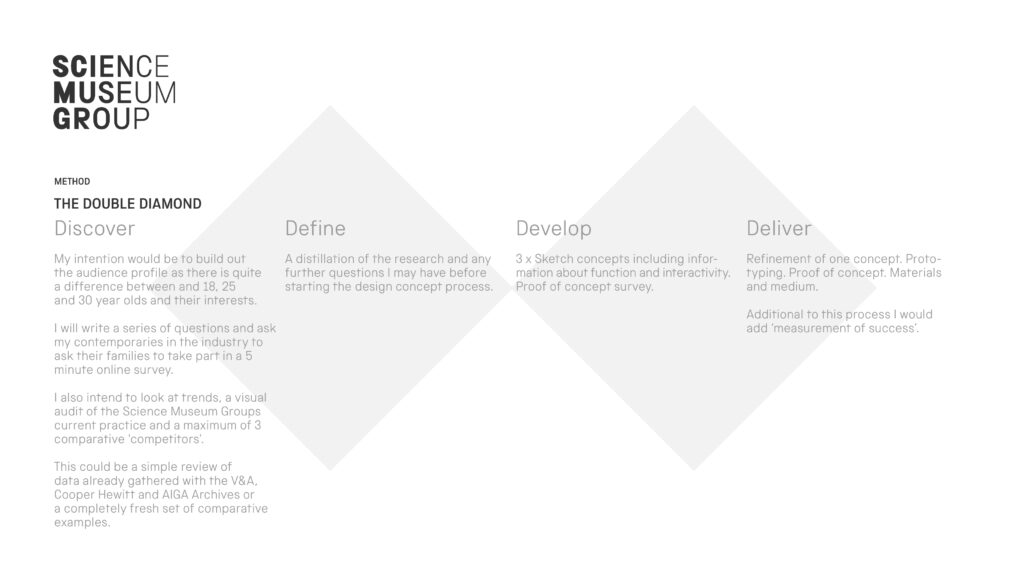
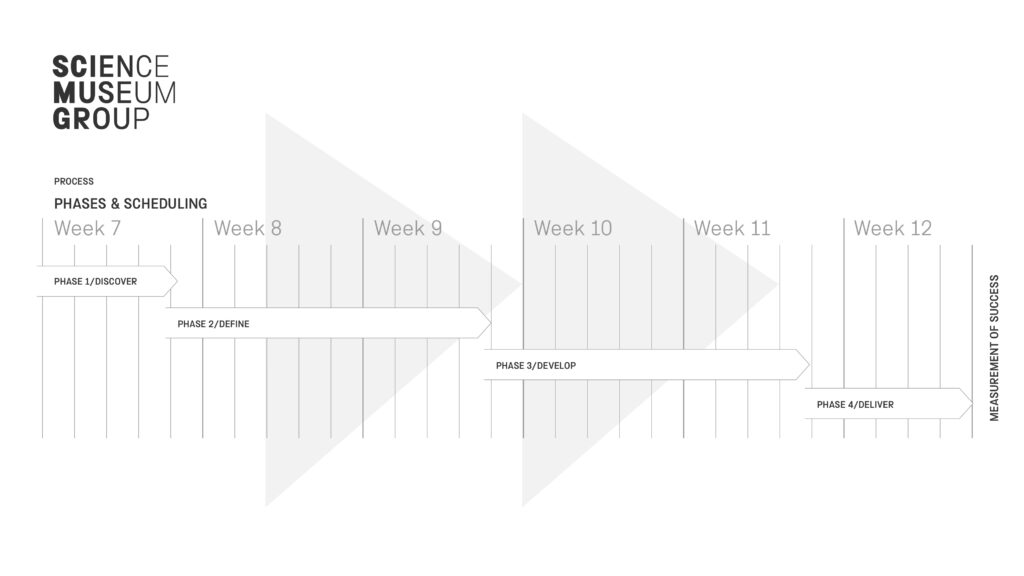
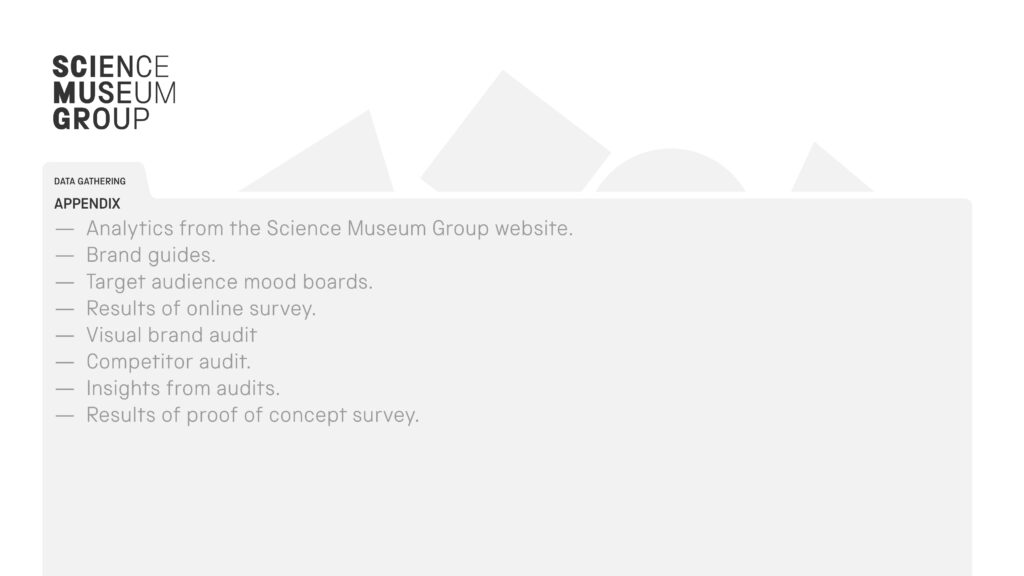
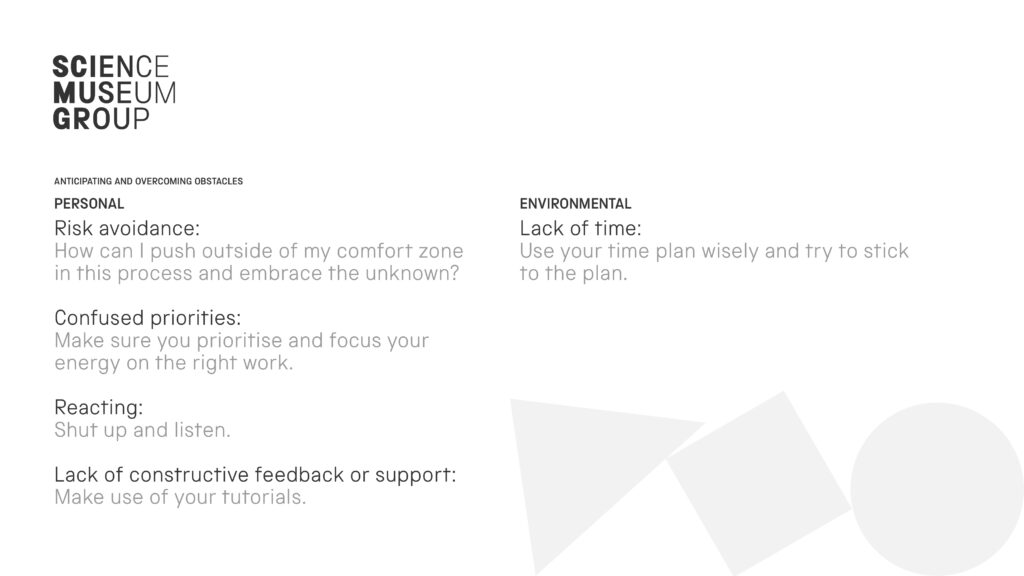
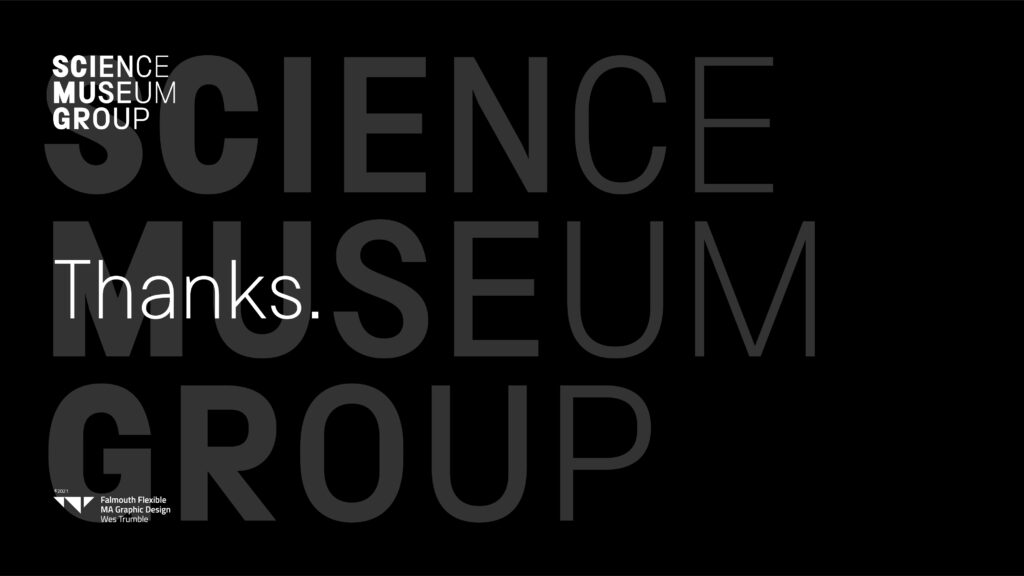
—
—
POSTSCRIPT
On reflection I realise that I have made a couple of serious errors with this weeks brief. The first is within my own research into design strategy. I chose to read Michael Johnson's section on strategy in his book 'Branding - in five and a half steps'. While I completely understand that this is not about design strategy it does cover some really insightful material. However, in choosing this path, the information has not aided me in coming up with my own path for my project.
The second mistake was exactly this: Not stating a position on strategy other than that of following the design brief. I do however feel that more research on my part needs to be done before I can state a position or direction. I have ideas of areas I would like to explore but need to gain a better understanding of my audience, the visual landscape of the brand, their competitors and new and emerging technologies first.

